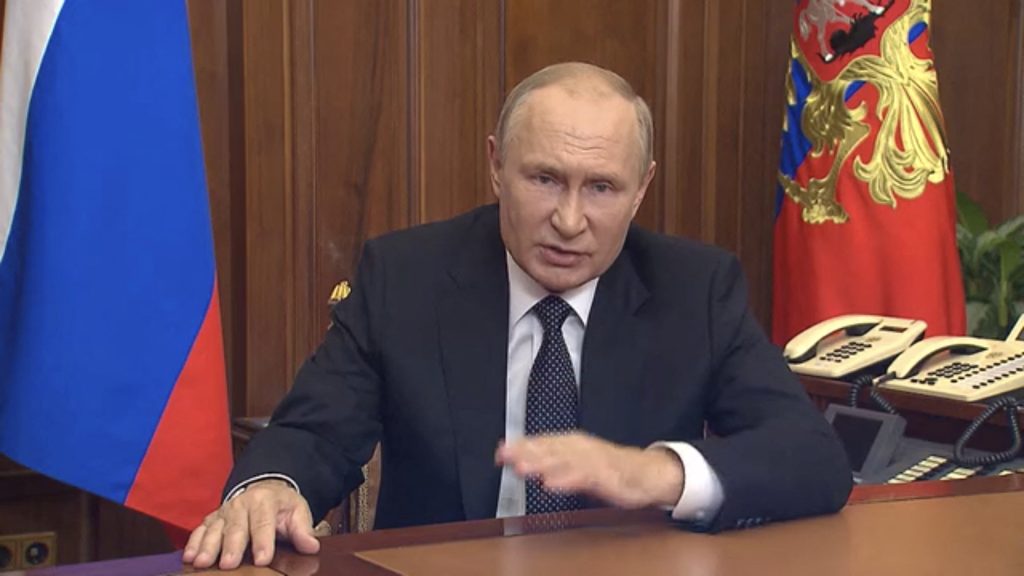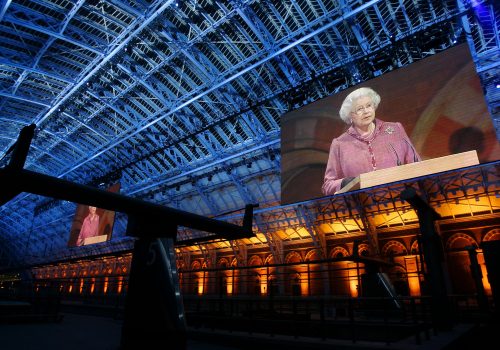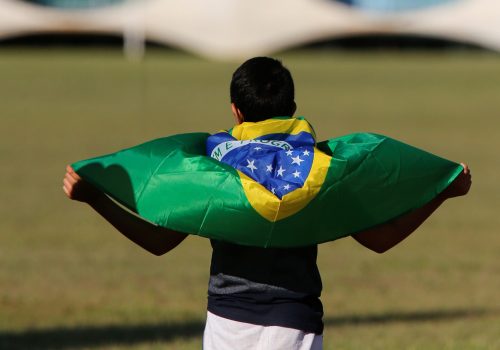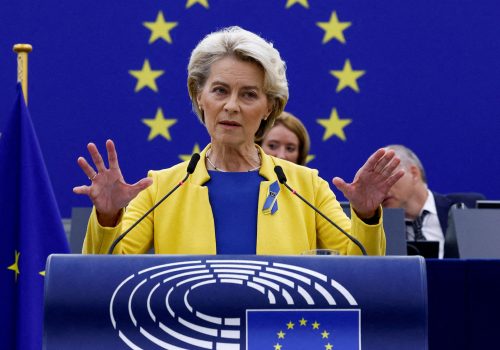This piece was updated on September 21, 2022.
The world is entering the moment of maximum danger—and at the same time of maximum opportunity—in Russian President Vladimir Putin’s war in Ukraine, now in its seventh month.
It is the moment of maximum danger because Putin is so dramatically failing in the pursuit of his delusional obsession, which prompted him to launch a major invasion of Ukraine on February 24, that he could rebuild some modern notion of the Russian empire with Kyiv as its centerpiece and as his legacy.
As Ukrainian courage and resilience transform his hubris into humiliation, the danger is rising that he could turn to weapons of mass destruction, including the use of tactical nuclear weapons, to coerce Ukraine and confound its allies at a time when Putin’s influence is eroding and he is running out of options. This peril was plainly evident on Wednesday when, in announcing a partial mobilization of Russian forces to buttress his flagging war in Ukraine, Putin once again threatened to use nuclear weapons. “Russia will use all the instruments at its disposal to counter a threat against its territorial integrity—this is not a bluff,” the Russian president declared.
This presents a moment of maximum opportunity for world leaders at the gathering this week of the United Nations General Assembly (UNGA), the first since Putin launched his war. It’s a chance for US President Joe Biden, alongside his European and Asian allies, to openly discuss the dangers Putin’s war poses to any country that cares about national sovereignty, to condemn Putin’s indisputable war atrocities, and to sway those remaining fence-sitters around the world who have neither condemned Putin nor backed sanctions against him.
It’s disheartening that the UN, instead of focusing on how best to stop Russia’s despot now and before winter wages, has been wrestling with the technicality of whether Ukrainian President Volodymyr Zelenskyy should be allowed to speak via video link to this most significant gathering of world leaders. The good news is that UN General Assembly members voted 101 to 7, with 19 abstentions that included China, to provide the Ukrainians their stage.
Russia, a member of the UN Security Council, had been doing everything in its power to block the speech. That’s no surprise, for when Zelenskyy spoke virtually to the Security Council in April, he told the group that it should act for peace immediately or “dissolve” itself.
“We are dealing with a state that turns the right of veto in the UN Security Council into a right to kill,” he warned. Zelenskyy could not have been more prophetic, saying that if the UN failed to stop Putin, then for countries going forward, it wouldn’t be international law that would define the future but rather the law of the jungle.
There has been some speculation that the chance that Putin will use tactical nukes against Ukraine—or order some other escalatory action involving chemical or biological agents—has grown in rough proportion to the Russian despot’s increasing military setbacks on the ground.
Scenes from Ukraine last week of Russian soldiers—who cast aside their rifles, fled the battlefield on bicycles, and ditched their uniforms to disguise themselves as locals—were all part of a mosaic of failure.
The spectacular implosion of Putin’s military in the south and east of Ukraine, where Ukrainian troops have retaken at least 2,320 square miles of territory, has given new life to talk that Putin may have no way out of a losing war except through a self-defeating Hail Mary: nuclear weapons.
For a leader whose claim to leadership has all along focused on his personal masculinity and political invulnerability, this growing perception of his military’s ineptness and his own weakness endangers his continued rule.
That, in turn, seems to be prompting a rethink among both the handful of his allies and a larger group of countries—India chief among them—as Putin learned at the Shanghai Cooperation Organization summit last week in Samarkand. Indian Prime Minister Narendra Modi expressed his concern about the war by telling Putin publicly that “today’s era is not an era of war, and I have spoken to you on the phone about this.”
Putin’s meeting last week in Samarkand with Chinese President Xi Jinping also gave Putin no relief. Indeed, Putin perhaps began to see the limits of what the two men had called their “no limits” relationship in a statement just before the Beijing Olympics and before Putin launched his war. “We understand your questions and concern” about the war, Putin told Xi last week.
Personal survival remains the highest priority for autocrats. For Putin, that must be top of mind now. What’s less clear is what would ensure it. One possibility is resorting to weapons of mass destruction and particularly tactical nuclear weapons.
While the risk to Putin would be huge, the world must be ready for this contingency. The best way to do that would be to pre-empt him, deter him, and be proactive rather than reactive because the world knows his plot.
“I fear [Putin’s Russia] will strike back now in really unpredictable ways, and ways that may even involve weapons of mass destruction,” Rose Gottemoeller, a former deputy secretary general of NATO, told the BBC last week.
What concerns her is something that has been growing in importance in Kremlin strategy: tactical nuclear weapons that weigh a few kilotons or less—some with only one-fiftieth of the yield of the Hiroshima bomb. Such weapons aren’t designed to reach Washington or Berlin but rather to coerce or, as Gottemoeller puts it, “to get the Ukrainians, in their terror, to capitulate.”
In an Atlantic Council “Memo to the President” last week, Matthew Kroenig tries to answer the question of “how to deter Russian nuclear use in Ukraine–and respond if deterrence fails.”
“Such nuclear use,” writes Kroenig, “could advance the Kremlin’s military aims, undermine US interests globally, and set off a humanitarian catastrophe unseen since 1945. To deter such a potential disaster, the United States should issue public, deliberately vague threats of serious consequences for any Russian use of nuclear weapons and be prepared to follow through with conventional military strikes on Russian forces if deterrence fails.”
It is also essential that the United States convey this message privately at senior levels and accompany it with the movement of relevant conventional forces into the area in a way that underscores the United States’ seriousness.
As world leaders gather at UNGA, one hopes they use the chance they have to fully listen to Zelenskyy.
Ukraine’s ability to survive as an independent, sovereign, and democratic state has wide-reaching implications for the international community that the UN represents.
There are terrible dangers in the weeks ahead. However, Putin’s battlefield failures and the increasing erosion of his international standing provide an opportunity to do the right thing: accelerate and step up all efforts to ensure Putin’s defeat and Ukraine’s defense.
If not now, when?
This article originally appeared on CNBC.com.
Frederick Kempe is president and chief executive officer of the Atlantic Council. You can follow him on Twitter @FredKempe.
THE WEEK’S TOP READS
#1 The World Putin Wants
Fiona Hill and Angela Stent | FOREIGN AFFAIRS
In this week’s must-read, Angela Stent and Fiona Hill, two of the smartest Russia-watchers anywhere, offer up a compelling analysis of Putin’s warped worldview, his strategy, and the sacrifices he’s willing to make in Ukraine.
“The real pinch from Western export controls will be felt in 2023,” they write, “when Russia will lack the semiconductors and spare parts for its manufacturing sector, and its industrial plants will be forced to close. The country’s oil industry will especially struggle as it loses out on technology and software from the international oil industry.” Yet Putin, they warn, is confident that he can outlast the West and is willing to put up with immense damage to the Russian economy if need be.
And why have countries in the world not joined US support for Ukraine?
“Since 2014,” write Stent and Hill, “Putin has assiduously courted ‘the rest’—the developing world—even as Russia’s ties with the West have frayed. In 2015, for example, Russia sent its military to the Middle East to support Syrian President Bashar al-Assad in his country’s civil war. Since then, Russia has cultivated ties with leaders on all sides of that region’s disputes, becoming one of the only major powers able to talk to all parties. Russia has strong ties with Iran, but also with Iran’s enemies: particularly Egypt, Israel, Saudi Arabia, and other Gulf states. In Africa, Russian paramilitary groups provide support to a number of leaders. And in Latin America, Russian influence has increased as more left-wing governments have come to power. There and elsewhere, Russia is still seen as a champion of the oppressed against the stereotype of US imperialism. Many people in the global South view Russia as the heir to the Soviet Union, which supported their post-colonial national liberation movements, not a modern variant of imperial Russia.” Read more →
#2 Fortress China: Xi Jinping’s plan for economic independence
James Kynge, Sun Yu, and Leo Lewis | FINANCIAL TIMES
To understand Xi’s economic goals, read this FT report, which examines China’s determination to achieve greater self-sufficiency from the rest of the world.
The underlying objective, the FT reports, “is to build a ‘fortress China’—re-engineering the world’s second-largest economy so it can run on internal energies and, if the need arises, withstand a military conflict. While many in the US want to ‘decouple’ their economy from China, Beijing wants to become less dependent on the West—and especially on its technology. The strategy has several constituent parts and—if successful—will take several years to realize… In technology, the aim is to spur domestic innovation and localize strategic aspects of the supply chain. In energy, the objective is to boost the deployment of renewables and reduce reliance on seaborne oil and gas. In food, the path to greater self-reliance includes revitalizing the local seed industry. In finance, the imperative is to counter the potential weaponization of the US dollar.” Read more →
#3 The Wrong Way to View the Xi-Putin Meeting
Evan A. Feigenbaum | CARNEGIE ENDOWMENT FOR INTERNATIONAL PEACE
“China is a self-interested power,” Feigenbaum writes. “It has every reason to be selfish about its own interests, not to run interference as a proxy for Moscow’s interests. China is the stronger power than Russia. And its interests are more global—and more multifaceted. Beijing’s goal is surely to preserve its entente with Russia at the strategic level, to counterbalance American power and growing economic pressure on China from the West. But it wants to do this without having to back Moscow at the tactical level, since it also benefits from preserving global market access, avoiding Western sanctions, and building relations with countries, like those in Central Asia, that are terrified of Russia.”
“This is a balance that Xi would struggle to strike if he appears to back Putin or the Russian war in Ukraine wholesale,” Feigenbaum adds.
For Xi, who has grand ambitions for a Chinese-led world, tipping too far one way or the other is not worth the risk. Read more →
#4 What Russia’s Failure in Ukraine Means for Putin and the World
Yaroslav Trofimov | WALL STREET JOURNAL
The Wall Street Journal’s Yaroslav Trofimov has produced some of the best reporting on the war in Ukraine. It’s no surprise he would deliver the most compelling reflection, which is on the cover of the Journal’s Weekend Review section, on Putin’s current troubles and their meaning.
“Moscow’s recent military defeats, inflicted by a country that it never considered a serious adversary, have challenged Russia’s basic assumptions about itself and its role in the world,” Trofimov writes.
More importantly, Russia’s failures are also shifting international thinking. “The losses are prompting Russia’s partners, allies, and arms customers to reassess their relationships, with many voicing private shock about Moscow’s bungling even as they hold back from public criticism,” writes Trofimov.
And in this characteristically excellent piece, also from Trofimov, he examines how Russia has shifted tactics to increase its assaults on civilian infrastructure.
“Changing its strategy after stinging military defeats,” Trofimov writes, “Russia this week began a campaign of cruise-missile strikes on Ukraine’s civilian infrastructure. Wednesday’s initial attack on a dam in Kryviy Rih followed a strike on Monday that disabled the main power station in the country’s second-largest city of Kharkiv, knocking out electricity in much of eastern Ukraine. Ukrainian authorities have contained the damage, restoring services in a matter of hours. Still, a sustained Russian effort to destroy Ukrainian power stations, dams, bridges, and pipelines could over time severely degrade the country’s ability to function, especially as winter sets in.” Read more →
#5 The Queen Met 13 Sitting US Presidents, Who Basked in Her Global Prestige
Peter Baker | NEW YORK TIMES
In honor of the passing of Her Majesty Queen Elizabeth II, read Peter Baker’s New York Times reflection on her relationship with the thirteen different US presidents she met and the important role she played in the special relationship between the United States and the United Kingdom.
“The queen’s myriad encounters with presidents over the last seven decades… provided a regular tableau of the enduring British-American relationship,” Baker writes, “a symbol of the powerful bond between the onetime colonial power and the breakaway nation on the other side of the ocean. While Americans cast off the rule of the monarchy, many still revered it, and there was always something grand when a president met the queen.” Read more →
Atlantic Council top reads
Image: Russian President Vladimir Putin makes an address on the conflict with Ukraine, in Moscow, Russia, in this still image taken from video released September 21, 2022. Russian Presidential Press Service/Kremlin via REUTERS.



